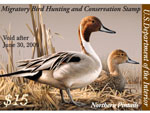2008 Federal Duck Stamp Contest Phone: 660-856-3323 |
Grassland Management
Since European contact in North America, more than 99% of tallgrass prairie has been destroyed primarily because of conversion to agricultural uses. Undisturbed, tall grass cover is not only valuable for nesting waterfowl, it provides habitat for other species, including quail, bitterns, northern harriers, short-eared owls, and many passerine birds.
Native grasses have root systems between five and nine feet deep, and because of this are excellent for long-term erosion control. They also grow well on poor soil because their deep roots can gain access to nutrients and water that shallower roots cannot reach. Introduced grasses, such as brome, are more easily established and are less expensive, but the cover often deteriorates in poor soil conditions as the sod opens up and weeds invade.
Native grass stands require several years to reach maturity, and usually require mowing in the midsummer during their first and second years. Once fully established, however, there are very few weeds which can compete with native grasses for nutrients and water in the soil.

Prescribed Burning
Prescribed burning is a tool used by land managers to provide many benefits. Burning reduces woody plant invasion and removes litter buildup in fields. Warm season grasses such as bluestem, switchgrass, and Indiangrass are stimulated by a properly-timed prescribed burn. When a burn is conducted in early April, cool season grasses have already begun to sprout, and will be badly damaged by the fire. However, warm season grasses are still dormant, and their underground energy reserves are unaffected.
The black ground that results from a burn increases soil temperatures, causing warm season grasses to sprout earlier, enabling them to compete with any cool season grasses that remain. Fall burning is not as effective because it allows cool season grasses to grow after the burn without competition. Burning may also be used to prepare a field for seeding by removing litter and other unwanted growth.



